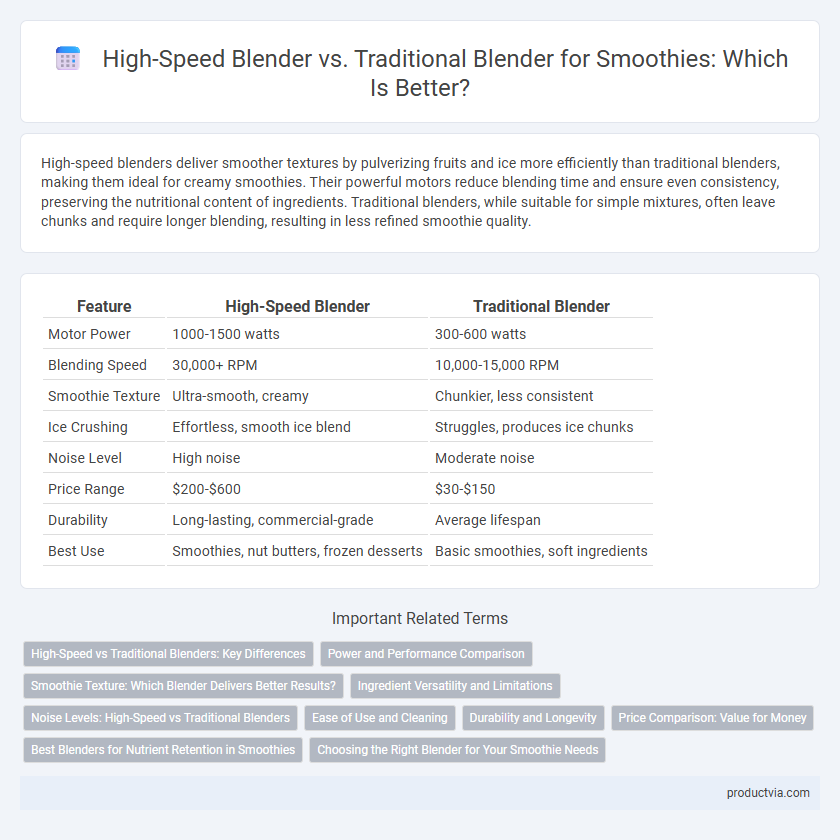High-speed blenders deliver smoother textures by pulverizing fruits and ice more efficiently than traditional blenders, making them ideal for creamy smoothies. Their powerful motors reduce blending time and ensure even consistency, preserving the nutritional content of ingredients. Traditional blenders, while suitable for simple mixtures, often leave chunks and require longer blending, resulting in less refined smoothie quality.
Table of Comparison
| Feature | High-Speed Blender | Traditional Blender |
|---|---|---|
| Motor Power | 1000-1500 watts | 300-600 watts |
| Blending Speed | 30,000+ RPM | 10,000-15,000 RPM |
| Smoothie Texture | Ultra-smooth, creamy | Chunkier, less consistent |
| Ice Crushing | Effortless, smooth ice blend | Struggles, produces ice chunks |
| Noise Level | High noise | Moderate noise |
| Price Range | $200-$600 | $30-$150 |
| Durability | Long-lasting, commercial-grade | Average lifespan |
| Best Use | Smoothies, nut butters, frozen desserts | Basic smoothies, soft ingredients |
High-Speed vs Traditional Blenders: Key Differences
High-speed blenders feature powerful motors exceeding 1,000 watts, enabling them to crush ice and blend tough ingredients into ultra-smooth textures ideal for smoothies. Traditional blenders typically operate at lower speeds with less motor power, resulting in chunkier textures and longer blending times. The advanced blade design and variable speed settings of high-speed blenders ensure efficient nutrient extraction and consistent smoothie quality compared to traditional models.
Power and Performance Comparison
High-speed blenders typically feature motors ranging from 1000 to 1800 watts, providing superior power that effortlessly crushes ice and blends fibrous ingredients into smooth textures. Traditional blenders usually have motors under 600 watts, resulting in slower performance and less consistent blending for thick smoothies. High-speed models also offer advanced blade designs and higher RPMs, enhancing their efficiency and ability to create velvety, restaurant-quality smoothies quickly.
Smoothie Texture: Which Blender Delivers Better Results?
High-speed blenders use powerful motors running at over 20,000 RPM to create ultra-smooth textures by thoroughly breaking down fruits, vegetables, and ice, resulting in creamier smoothies with fewer chunks. Traditional blenders usually operate at lower speeds around 10,000 to 15,000 RPM, often producing coarser blends with noticeable pulp or ice fragments. For achieving silky, restaurant-quality smoothie texture, high-speed blenders consistently outperform traditional models due to their enhanced blade design and superior blending power.
Ingredient Versatility and Limitations
High-speed blenders offer superior ingredient versatility for smoothies, effortlessly blending tough greens, frozen fruits, nuts, and seeds into a smooth consistency, whereas traditional blenders often struggle with fibrous or hard ingredients, resulting in a chunkier texture. The powerful motor and advanced blade design of high-speed blenders enable the extraction of more nutrients and smoother blends, while traditional blenders are typically limited to softer fruits and basic ingredients. Limitations of traditional blenders include reduced efficiency with ice and tough mixtures, making high-speed blenders more suitable for diverse and nutrient-rich smoothie recipes.
Noise Levels: High-Speed vs Traditional Blenders
High-speed blenders typically operate at much higher RPMs, generating more noise compared to traditional blenders, which usually have slower motors and quieter performance. Noise levels in high-speed blenders can exceed 90 decibels, making them noticeably louder during smoothie preparation, while traditional blenders often measure around 60-70 decibels. Choosing between these options involves balancing the power and blending efficiency of high-speed blenders against the reduced noise output of traditional models.
Ease of Use and Cleaning
High-speed blenders feature powerful motors and streamlined designs that make blending smoothies effortlessly smooth and quick, minimizing manual intervention. Traditional blenders often require multiple blending cycles and may struggle with tougher ingredients, making the process slower and more labor-intensive. High-speed blender components are typically dishwasher safe and designed for easy disassembly, enhancing overall cleaning efficiency compared to the more complex parts of traditional blenders.
Durability and Longevity
High-speed blenders feature robust motor construction and durable materials like hardened stainless steel blades designed to withstand continuous use, ensuring longer lifespan compared to traditional blenders. Traditional blenders often use lower-powered motors and plastic components that wear out faster under frequent use, reducing overall durability. Investing in a high-speed blender enhances reliability and longevity, making it ideal for daily smoothie preparation.
Price Comparison: Value for Money
High-speed blenders typically range from $200 to $600, offering powerful motors and durable construction that justify the higher price for frequent smoothie enthusiasts. Traditional blenders, priced between $30 and $100, provide basic blending capabilities suitable for occasional use but lack the efficiency and texture consistency of high-speed models. Consumers seeking value for money should weigh the investment against smoothie quality, blending speed, and long-term durability.
Best Blenders for Nutrient Retention in Smoothies
High-speed blenders, such as Vitamix and Blendtec, excel in nutrient retention by pulverizing ingredients at faster speeds, breaking down cell walls to release more vitamins and minerals in smoothies. Traditional blenders often operate at lower RPMs, resulting in less efficient blending and potentially lower nutrient absorption. For optimal nutrient retention, models with powerful motors and variable speed controls are recommended to create smoother textures and preserve essential nutrients.
Choosing the Right Blender for Your Smoothie Needs
High-speed blenders like Vitamix and Blendtec offer powerful motors exceeding 1200 watts, ensuring smooth, creamy textures by breaking down fruits and vegetables efficiently. Traditional blenders typically feature motors below 600 watts, suitable for simple blends but may leave chunks or require more blending time. Selecting the right blender depends on your smoothie ingredients and texture preferences, with high-speed models excelling in nutrient extraction and creaminess.
High-speed blender vs traditional blender for smoothies Infographic

 productvia.com
productvia.com